What Acrylic Painting Supplies are the Best to Buy?
I’ve been painting for 30 years, and in that time I have figured out some favorites when it comes to paint, brushes, and canvases. I get absolutely nothing from recommending these brands; these are just my favorites. All of these products deliver good quality and are well-priced, unless otherwise noted. If you want to find out the best acrylic painting tools including brushes, paints, canvases, and much more, then read on!
Acrylic Paint Recommendations
When it comes to paints, there are three things to consider: pigment load (concentration of pigment in the paint), lightfastness (how much it resists fading), and consistency. Cheaper brands of acrylic tend to have less pigment load, fade more quickly, and don’t have a refined, smooth consistency. Some cheap paints rub right off with water, even when dry. So, reserve the cheap paints for practicing. If you want your works to last, I recommend the higher quality paints. Here are my favorites.
Beginner/Intermediate Painter: Blick Studio Paints
Blick studio paints are good quality, have a decently high pigment load, and are very affordable. I now predominantly use Blick in my art workshops because I know the quality is good and the price point is just right.
Intermediate/Advanced Painter: Liquitex Professional Series or Golden Paints
Golden, in my opinion, is the best acrylic paint. They have a high pigment load and perform beautifully. They also have a wide variety of viscosities. Golden has a wealth of “how to” information on their website.
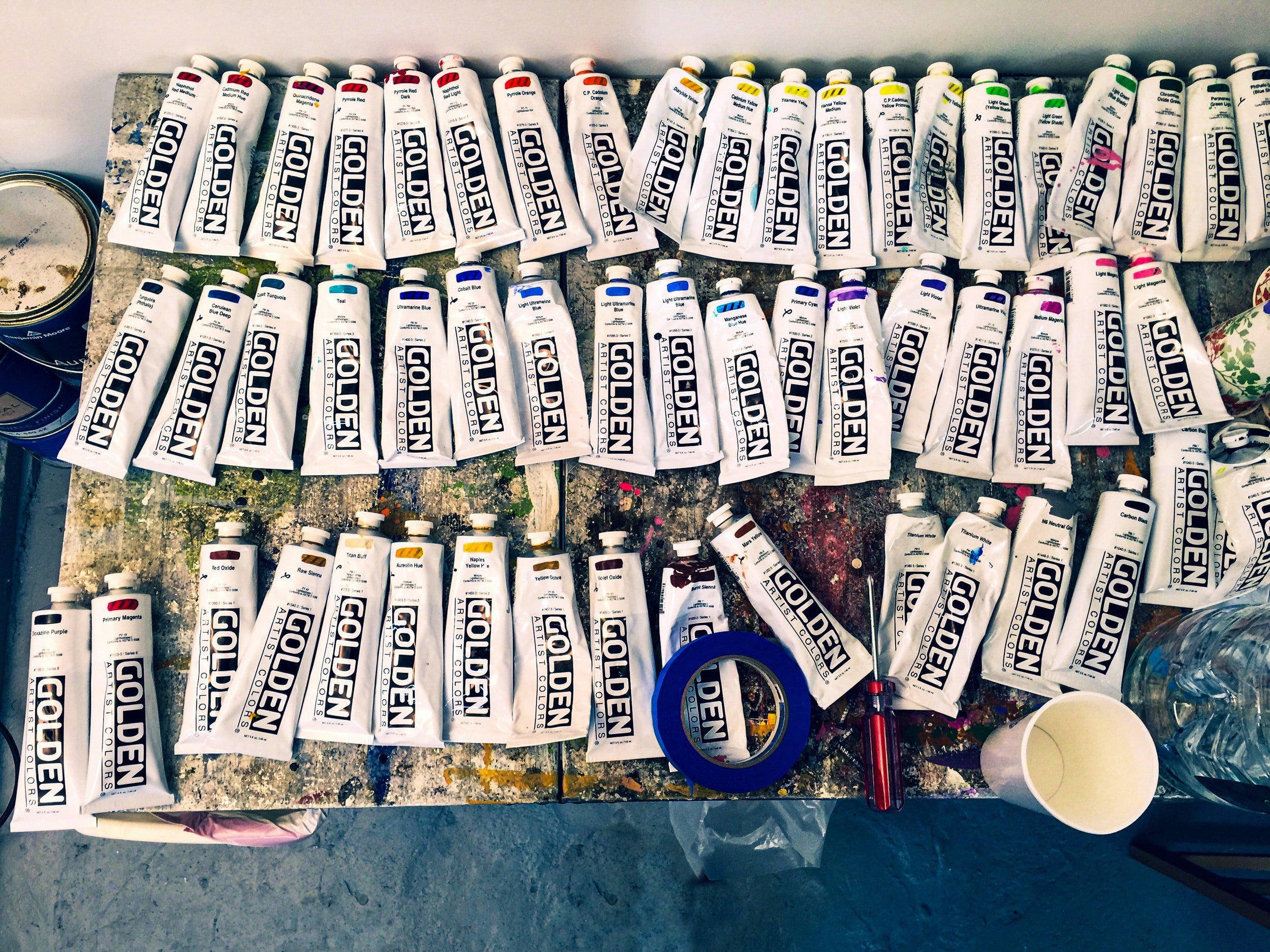
Golden Paint.
Liquitex Professional is also a great choice, and a bit more affordable. Just like Golden, they have a high pigment load and a variety of viscosities. Half of my paints are probably the Liquitex Professional series.
Do Not Use: Liquitex Basics. You get what you pay for here. My biggest problem with this line of paints is that they rub off with water even when dry. They are fine if you are truly playing or experimenting, but you might want to put a layer of Golden’s Glazing Medium between layers so the paint doesn’t rub off.
Paint Brush Recommendations
You will want to purchase a variety of brush types for acrylic painting. Typically brushes come in flats and rounds, so get at least a few. Some of the other brushes you could consider are fans and filberts. Also, match the size of your brush with the surface onto which you are painting. Be sure to get large sized brushes if you are working on anything over 20” x 20”. I usually skip numbers. So I will get a 2 and a 6 but skip on the 4 if the brushes are expensive. Down the road you can always add the in-between sizes if you feel you need them.
Beginner/Intermediate: Blick Scholastic Wonder–great all purpose brush at a good cost.
Intermediate/Pro: Princeton Summit 6100–for low to medium viscosity paint, good for blending
Princeton Catalyst Series–for all viscosity paint, even paint with heavy gel mediums.
Large Round Brushes: Escoda Chungking–these are among my favorite brushes! They make big, bold marks, which I love!
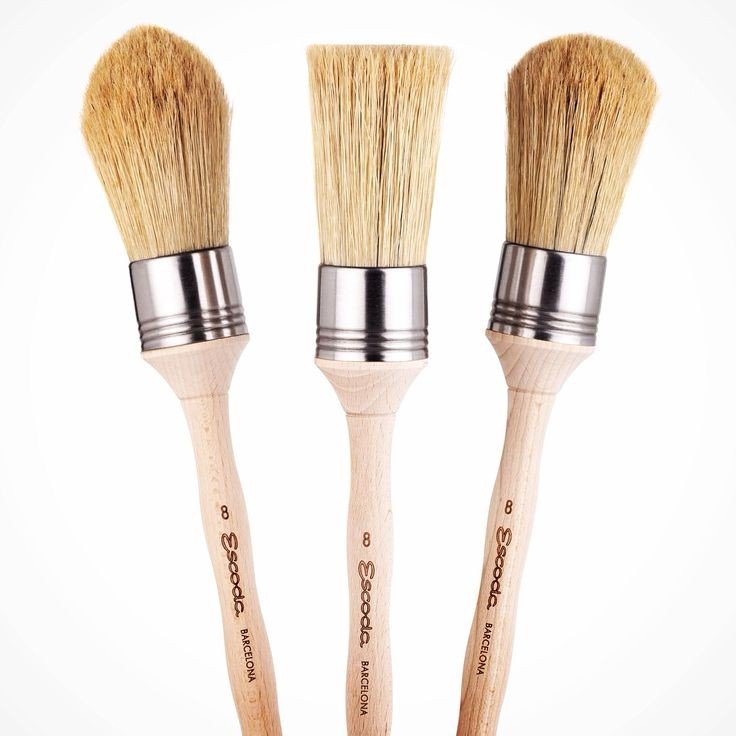
Escoda Brushes. LOVE!
Palette Knives
Palette knives are used to mix and apply acrylic paint. I often paint with a palette knife, especially when I am using heavy mediums mixed in with my paints.
Blick makes a decent set. Get a wide variety of sizes and shapes. Liquitex also interesting shapes of palette knives and painting spatulas.
Painting Surfaces
When it comes to acrylic painting, you want to shoot for porous surfaces such as canvas, wood, and paper. You can choose surfaces that are pre-gessoed or not. Some artists like to use acrylic paint on un-gessoed surfaces. This yields a different effect and is worth experimenting with. Most people will tell you to gesso first because that’s how the acrylic sticks to the surface. However, I’ve been experimenting with painting pours on un-gessoed canvas, and I love the stain effect it produces. Some rules are meant to be broken!
Canvas
Beginner: Michael’s Super Value by Artists’ Loft
These canvases are a fantastic deal and decent enough quality. A pack of 5 canvases is about $13 depending on the size. These canvases are often a bit loose when I get them, but all you need to do is spritz some water on the back and use a warm hair dryer to tighten it up. Don’t tighten it too much or the wood frame part of the canvas will warp! These are great for practice pieces. Michael’s always offers coupons, too, so this makes buying these canvases even more cost effective.
Intermediate/Advanced: Blick Premier Stretched Cotton Canvas
These are great quality canvases for an excellent price point. They have the wide 1.5” profile so that you can paint around the sides of the canvas and hang right on the wall without a frame (gallery wrap). They are usually tight and perfectly square, and arrive to my house undamaged. I have ordered a lot of Dick Blick art supplies for my personal artwork. Their customer service is great, so if a canvas arrives bent, rest assured they will send you a new one!
There are more expensive stretched canvas options out there, but unless you are selling your artwork on a regular basis, the Blick Premier canvases should work well. You might check out your local art store if you want professional stretched canvases. My local art store, Artisan’s, makes awesome stretched canvases, so if you are in the Santa Fe or Albuquerque area check them out. Generally speaking, I would recommend starting out with Blick’s Premier line, and if you want something better, then move up the ladder of investment!
Wood Panels
Have you painted on wood? If not, it’s a totally different experience. I love how smooth it is to work on wood, and how the wood grain is visible in different parts of the painting. What’s nice about wood panels are that they are not as delicate as canvas, so you can scrape and lay down lots of texture and rough the surface up without worrying about damaging the canvas.
Most Economical: Go to local wood stores or Home Depot/Lowes. Grab a plywood or hardwood sheet (4’ x 8”) and have them cut it up for you. Lowes usually won’t cut anything smaller than 12”. Here’s an example at Lowe’s.
Another option is the circular wood panels at Lowe’s. This is an economical way to work on wood, and I think a circular painting would be super unique! If the surface is not smooth, I would gesso this really well. You might also consider sanding it first. The circular wood panel is also a great option if you do encaustic painting.
Mid-Range: Ampersand Birch Value Packs or Blick Studio Wood Panels
You will find the surface of these much smoother than the panels at Lowe’s. This is a good product if you want to see what it’s like to paint on wood.
Blick also makes a premier wood panel that is well-priced and excellent quality.
Expensive: Ampersand Wood Panels. Superior quality. These are amazing panels if you are serious about painting on wood! They come un-gessoed, or gessoed.
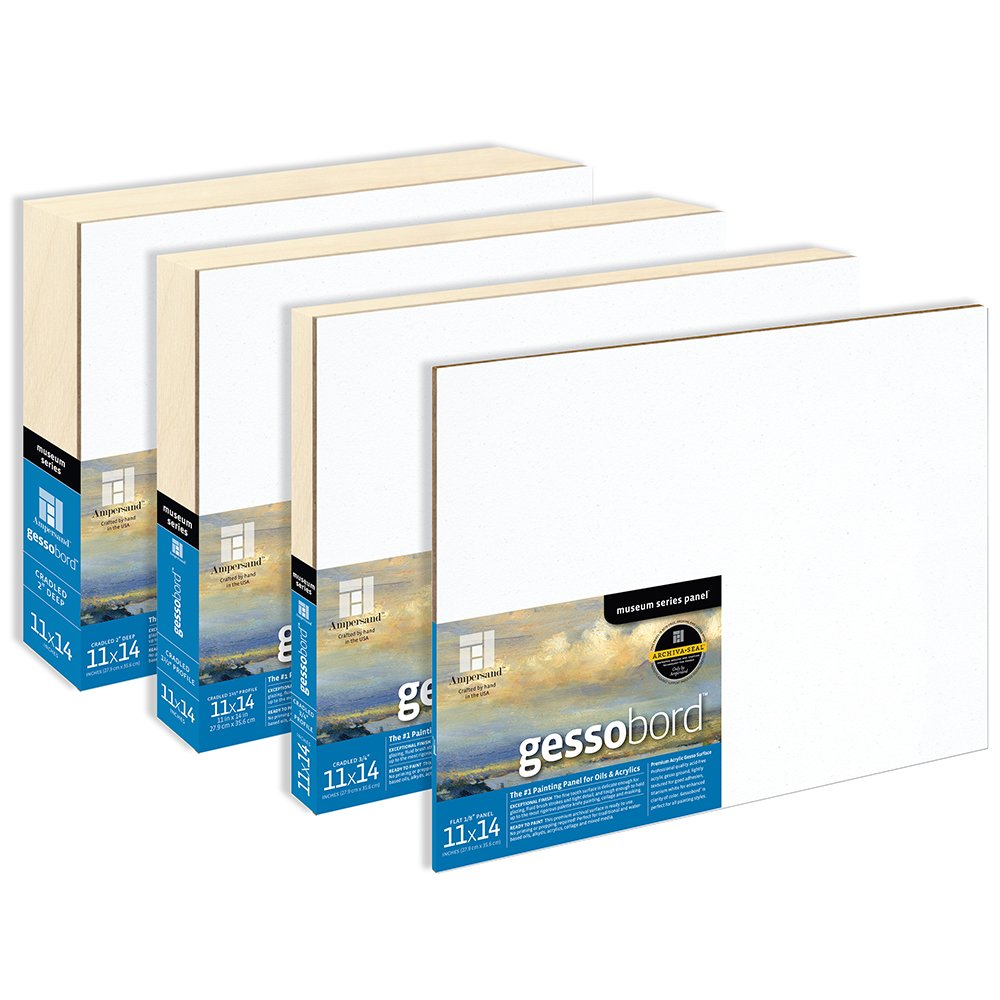
Amersand’s Gessobord
Acrylic Paper
For all levels: Strathmore 400 Series Acrylic Painting Pad
I LOVE this paper! I do demonstrations on it and use it for workshops in which students don’t want to carry stretched canvas home. I have worked on the same piece of paper over and over again, and it holds up really well. Plus, it is acid-free so can be framed safely if you make a masterpiece with it!
Palettes
Another acrylic painting tool you `For acrylic painting, don’t buy those adorable wooden palettes with the thumb whole. I know, wearing the beret and holding the cute little wooden palette is THE artist stereotype, but wood palettes are for oil paint, and won’t be as easy to scrape the acrylic off as glass is.
What I recommend is to make your own palette out of glass. I go to my local glass store and ask to buy off-cuts, and sometimes they give it to me for free. Wear safety gloves AT ALL TIMES when handling glass! I would try to get a rectangular piece of glass that is at least 18” x 10” or so. It’s nice to have a big palette, so don’t go too small.
How to make your own glass acrylic painting palette:
1–Put on safety gloves! The sides of the glass will be VERY sharp!
2–Cut a piece of cardboard to match the size of the glass you purchased.
3–Gesso the cardboard on at least one side of the cardboard and let it dry.
4. Paint another coat of gesso and let dry again.
5–Make sure the gessoed side is facing up so it’s visible through the glass. Tape the cardboard to the glass around the sides with enough layers of duct tape to make the corners soft (not sharp and pointy!). Look at the image to the right and notice how painted white on the cardboard gives the palette a bright white surface. That’s because the best color to mix against IS white—you can see the true hue of the color that way.
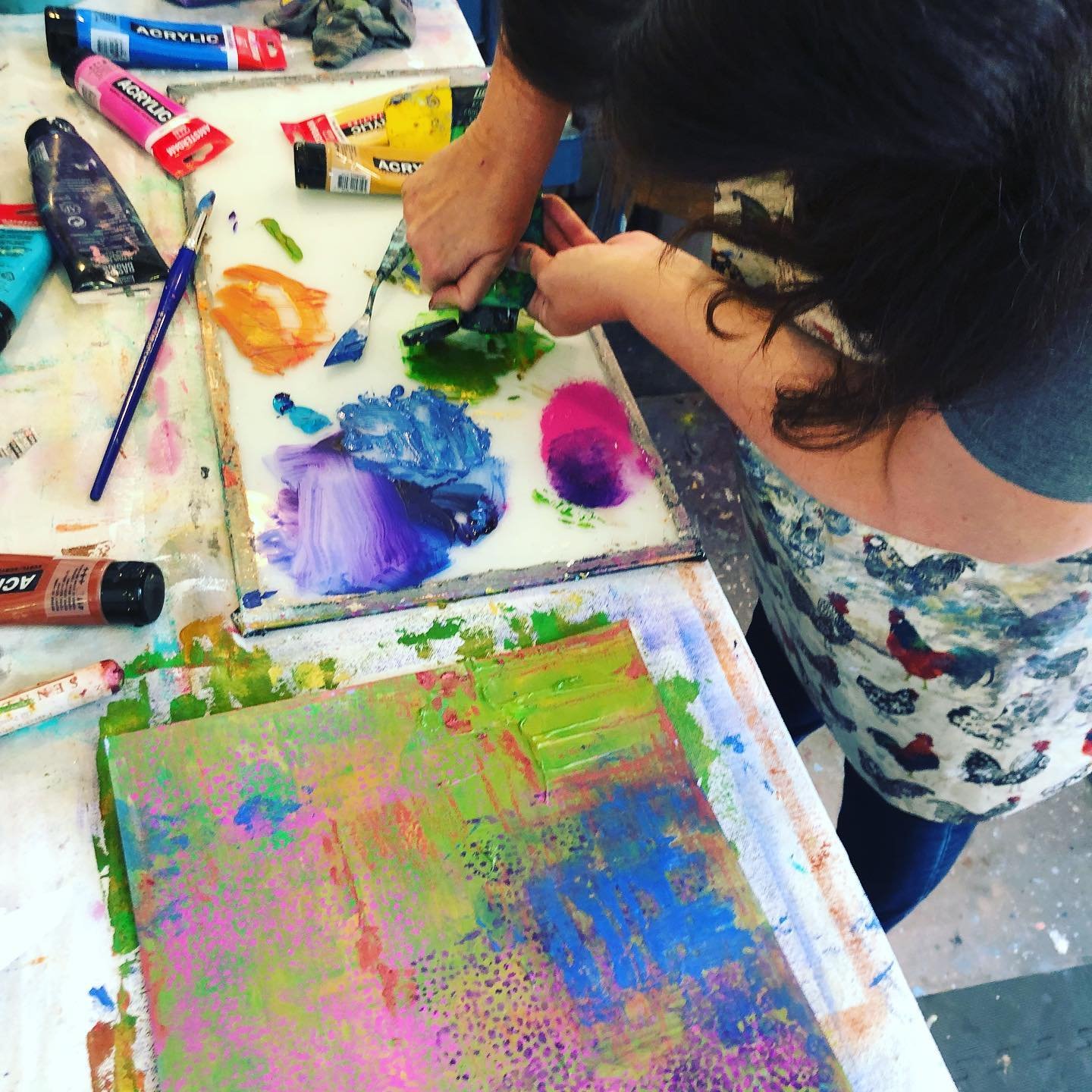
Student Using One of My Handmade Glass Palettes
I hope these recommendations are helpful to you. Feel free to comment on what products/brands YOU love to use!
ABOUT ANDREA CERMANSKI
I am an artist out of Santa Fe, New Mexico who has been painting for almost 30 years. I love to teach first-timers as well as experienced painters who need a creative reboot. My work has been displayed in several galleries around the country, and I have a Bachelor’s in Art History, a Master’s in Art Education, and had my work in a show juried by Judy Chicago. The idea of getting more people painting makes me light up as I want to inspire more people to express their creative selves and tap into a place of joy and calm.
WANT TO LEARN MORE?
- Subscribe and get one of the FREEBIES below!
- PDF explaining How to Use My 5 Favorite Mediums
- Ebook on How to Move From Representational Painting to Abstraction: 5 Transformative Art Lessons
- 8 Colors Every Artist Should Have: My list of BEST colors to buy and pro mixing tips
- Check out My Online Abstract Painting Course
- Read More Painting Tips Blog Posts
- Check out My Paintings & Art Prints for Sale
- Follow Me On YouTube, Instagram, or Pinterest
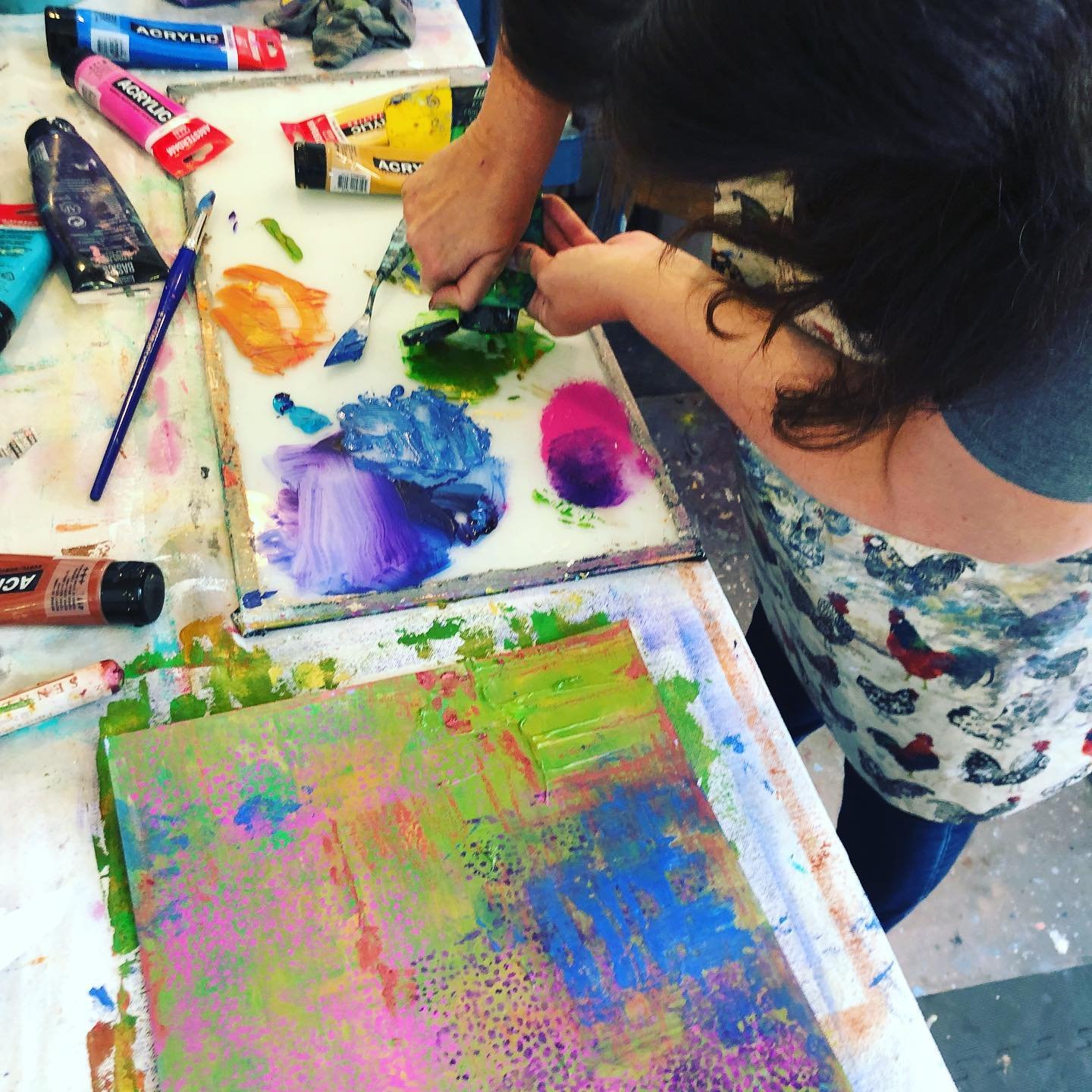
This information is exactly what I need to get started painting at home. THANK YOU for the detailed list of supplies and the focus on budget!
You are very welcome! So glad this helped!
You are welcome! I TOTALLY understand the high cost of all the supplies, and I have tried a lot of different things. Let me know what products you end up loving:)
For beginner/intermediate artists, what do you think of Windsor & Newton Galleria?
I bet they are great, but I have not used them personally. Windsor & Newton is typically a very solid brand.
Thank you so much!
You are very welcome! Glad the post was helpful:)